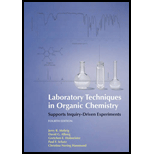
Interpretation:
Whether the two substances in the TLC analysis are identical or not should be determined. Also, the additional experiment that can be performed to identify them if they are not identical should be determined.
Concept introduction:
Thin-layer chromatography (TLC) is an analytical technique used to identify whether two compounds are identical or not and also to determine the number of compounds in a mixture.
In TLC, glass, metal, or plastic plates are used that are coated with a thin layer of adsorbent, which acts as a stationary phase. The stationary phase usually used is polar silica gel. The mobile phase is a pure solvent or a mixture of solvents. It is also known as a developing agent. Mostly nonvolatile solid organic samples are analyzed by thin-layer chromatography. However, TLC cannot be used for volatile liquid compounds because it leads to loss of the sample by evaporation from the TLC plate.
In TLC analysis, a small amount of the mixture to be separated is dissolved in a suitable solvent and applied on the TLC plate. Then the plate is placed in a closed chamber immersed in the mobile phase called the developing solvent. The solvent rises through the stationary phase by capillary action. As the solvent rises the plate, the sample is distributed between the mobile phase and the stationary phase on the basis of their retention values. The more the compound interacts with the stationary phase, the more slowly it moves on the TLC plate. When silica gel is the stationary phase, the developing solvent moves nonpolar substances up the plate most rapidly. As the chromatogram develops, polar substances travel up the plate slowly.
The retention factor
Explanation of Solution
When two samples have identical
Also if TLC analyses are done subsequently with different developing solvents, then it can help to conclude that the samples are different compounds if different
Want to see more full solutions like this?
Chapter 18 Solutions
Laboratory Techniques in Organic Chemistry
- HPLC VFA analysis - why do I get so different peaks for very similar samples?arrow_forward1. Methanol and ethanol are separated in a capillary GC column with retention times of 370 and 385 s, respectively, and half widths (W₁/2) of 9.42 and 10.0 s. An unretained butane peak occurs at 10.0 s. Calculate the separation factor and the resolution.arrow_forwardYou spotted a mixture of three compounds, labeled A-C, on a silica plate. The resulting thin layer chromatography (TLC) plate with a mobile solvent mixture of 95 % hexanes and 5 % ethyl acetate is shown below. Which of the spots traveled the furthest up the TLC plate corresponding to spot 3?arrow_forward
- IN GC, What effect does changing from a temperature ramp to an isothermal temperature program have on resolution of peaks at the beginning of the chromatogram versus the end of the chromatogram. Consider molecular weight and boiling point of the analytes.arrow_forward4. You analyze a mixture of cyclopentane, pyrrolidine, and tetrahydrofuran by gas chromatography and obtain the following GC trace. H N O cyclopentane pyrrolidine tetrahydrofuran area A = 100 A intensity area B = 70 B area C = 180 retention time (min) a) Label the peaks on the GC trace with the compounds they correspond to. Explain how you made your assignments. (Hint: look up the boiling points of the compounds.)arrow_forwardColumn chromatography is also very useful for separating mixtures of organic compounds that are not coloured. Briefly explain how you could use column chromatography for the separation of a colourless mixture, and how you could identify your separated compounds.arrow_forward
- In an experiment of Reverse Phase chromatography using C-18 stationary phase and a mixture of methanol/ethyl acetate/acetic acid, a researcher tried to separate the 3 compounds shown below. Which compound would have the lowest Rf and which the highest Rf in this experiment? Explain your answer and show any relevant structures.arrow_forwardCalculate the separation factor (or selectivity factor), between two compounds, 1 and 2, whose retention volumes are 6mL and 7mL, respectively. The dead volume of the column used is 1mL. Show that this factor is equal to the ratio of the distribution coefficients K2/K1 of these compounds tR(1)<tR(2).arrow_forwardA student places an unknown sample on a thin-layer chromatography plate and develops it in dichloromethane as a solvent. Only one spot whose Rf is 0.98 is observed. Does this result indicate that the unknown material is a pure compound? If not a pure compound, suggest an alternate procedure to verify the purity of the sample.arrow_forward
- SFC combines important advantages of gas and liquid chromatography. It is especially useful for analyzing compounds which cannot be determined using either GC or LC. Qualify the statementarrow_forwardA student used thin layer chromatography to confirm whether he could successfully separate two compounds. Here is the TLC plate he obtained after 30 min. Stationary phase was silica gel and mobile phase was 95 % ethyl acetate and 5 % Hexane mixture.arrow_forwardMethylcyclohexane and methylcyclohexene were separated by gas chromatography in a capillary column, which showed retention times of 10.0 and 10.9 minutes, respectively. The width at base were found to be 0.76 and 0.82 minutes for methylcyclohexane and methylcyclohexene, respectively. An un-retained air peak occurs at 1.9 minutes. Calculate the column resolution (Rs) and the average retention factor (k).arrow_forward
 EBK A SMALL SCALE APPROACH TO ORGANIC LChemistryISBN:9781305446021Author:LampmanPublisher:CENGAGE LEARNING - CONSIGNMENT
EBK A SMALL SCALE APPROACH TO ORGANIC LChemistryISBN:9781305446021Author:LampmanPublisher:CENGAGE LEARNING - CONSIGNMENT Principles of Instrumental AnalysisChemistryISBN:9781305577213Author:Douglas A. Skoog, F. James Holler, Stanley R. CrouchPublisher:Cengage Learning
Principles of Instrumental AnalysisChemistryISBN:9781305577213Author:Douglas A. Skoog, F. James Holler, Stanley R. CrouchPublisher:Cengage Learning


